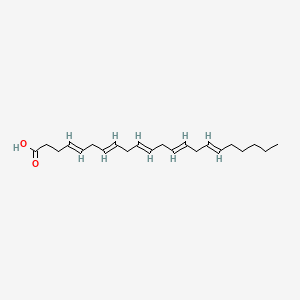| MeSH term | MeSH ID | Detail |
|---|---|---|
| Kidney Failure, Chronic | D007676 | 51 associated lipids |
| Body Weight | D001835 | 333 associated lipids |
| Heart Failure | D006333 | 36 associated lipids |
| Hypersensitivity | D006967 | 22 associated lipids |
| Weight Gain | D015430 | 101 associated lipids |
| Cell Transformation, Neoplastic | D002471 | 126 associated lipids |
| Hypercholesterolemia | D006937 | 91 associated lipids |
| Alzheimer Disease | D000544 | 76 associated lipids |
| Carcinoma, Hepatocellular | D006528 | 140 associated lipids |
| Hyperlipidemias | D006949 | 73 associated lipids |
4,7,10,13,16-docosapentaenoic acid
4,7,10,13,16-docosapentaenoic acid is a lipid of Fatty Acyls (FA) class.
Cross Reference
There are no associated biomedical information in the current reference collection.
Current reference collection contains 1422 references associated with 4,7,10,13,16-docosapentaenoic acid in LipidPedia. Due to lack of full text of references or no associated biomedical terms are recognized in our current text-mining method, we cannot extract any biomedical terms related to diseases, pathways, locations, functions, genes, lipids, and animal models from the associated reference collection.
Users can download the reference list at the bottom of this page and read the reference manually to find out biomedical information.
Here are additional resources we collected from PubChem and MeSH for 4,7,10,13,16-docosapentaenoic acid
Possible diseases from mapped MeSH terms on references
We collected disease MeSH terms mapped to the references associated with 4,7,10,13,16-docosapentaenoic acid
NCBI Entrez Crosslinks
All references with 4,7,10,13,16-docosapentaenoic acid
Download all related citations| Authors | Title | Published | Journal | PubMed Link |
|---|---|---|---|---|
| Daneshmand R et al. | Associations of serum n-3 and n-6 polyunsaturated fatty acids with plasma natriuretic peptides. | 2016 | Eur J Clin Nutr | pmid:27071511 |
| Markworth JF et al. | Divergent shifts in lipid mediator profile following supplementation with n-3 docosapentaenoic acid and eicosapentaenoic acid. | 2016 | FASEB J. | pmid:27461565 |
| Primdahl KG et al. | Synthesis of 13(R)-Hydroxy-7Z,10Z,13R,14E,16Z,19Z Docosapentaenoic Acid (13R-HDPA) and Its Biosynthetic Conversion to the 13-Series Resolvins. | 2016 | J. Nat. Prod. | pmid:27704804 |
| Berge RK et al. | Krill oil reduces plasma triacylglycerol level and improves related lipoprotein particle concentration, fatty acid composition and redox status in healthy young adults - a pilot study. | 2015 | Lipids Health Dis | pmid:26666303 |
| Linhartova P and Sampels S | Combined incubation of cadmium, docosahexaenoic and eicosapentaenoic acid results in increased uptake of cadmium and elevated docosapentaenoic acid content in hepatocytes in vitro. | 2015 | Lipids Health Dis | pmid:26627047 |
| Kim SH et al. | Heterologous Reconstitution of Omega-3 Polyunsaturated Fatty Acids in Arabidopsis. | 2015 | Biomed Res Int | pmid:26339641 |
| Skulas-Ray AC et al. | Red Blood Cell Docosapentaenoic Acid (DPA n-3) is Inversely Associated with Triglycerides and C-reactive Protein (CRP) in Healthy Adults and Dose-Dependently Increases Following n-3 Fatty Acid Supplementation. | 2015 | Nutrients | pmid:26247967 |
| Park HG et al. | The fatty acid desaturase 2 (FADS2) gene product catalyzes Δ4 desaturation to yield n-3 docosahexaenoic acid and n-6 docosapentaenoic acid in human cells. | 2015 | FASEB J. | pmid:26065859 |
| Morin C et al. | Eicosapentaenoic acid and docosapentaenoic acid monoglycerides are more potent than docosahexaenoic acid monoglyceride to resolve inflammation in a rheumatoid arthritis model. | 2015 | Arthritis Res. Ther. | pmid:26022389 |
| Tani S et al. | Association of Fish Consumption-Derived Ratio of Serum n-3 to n-6 Polyunsaturated Fatty Acids and Cardiovascular Risk With the Prevalence of Coronary Artery Disease. | 2015 | Int Heart J | pmid:25902881 |
